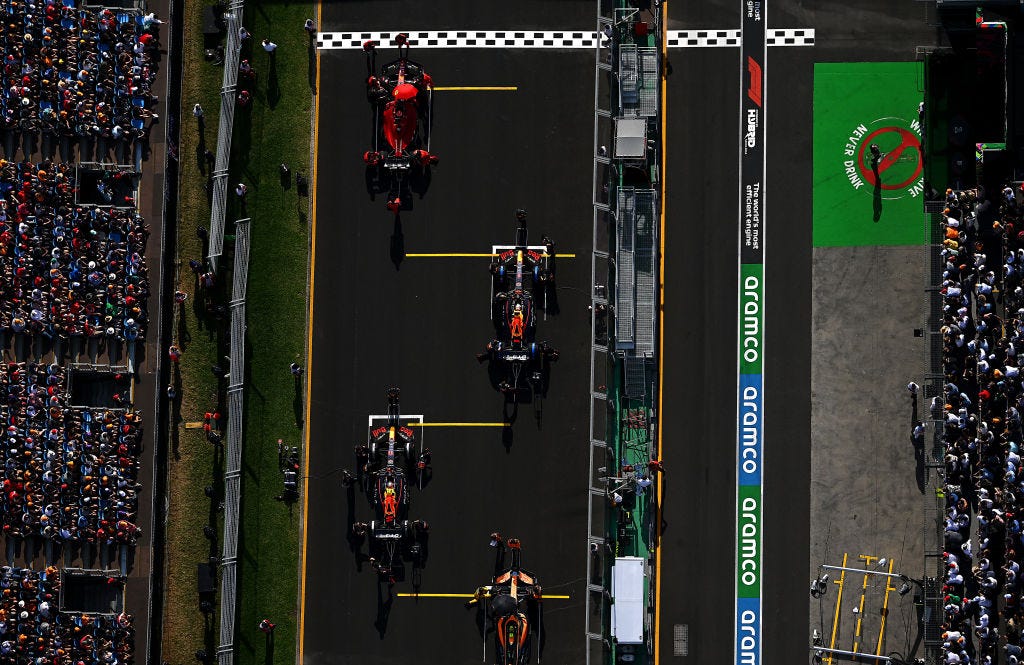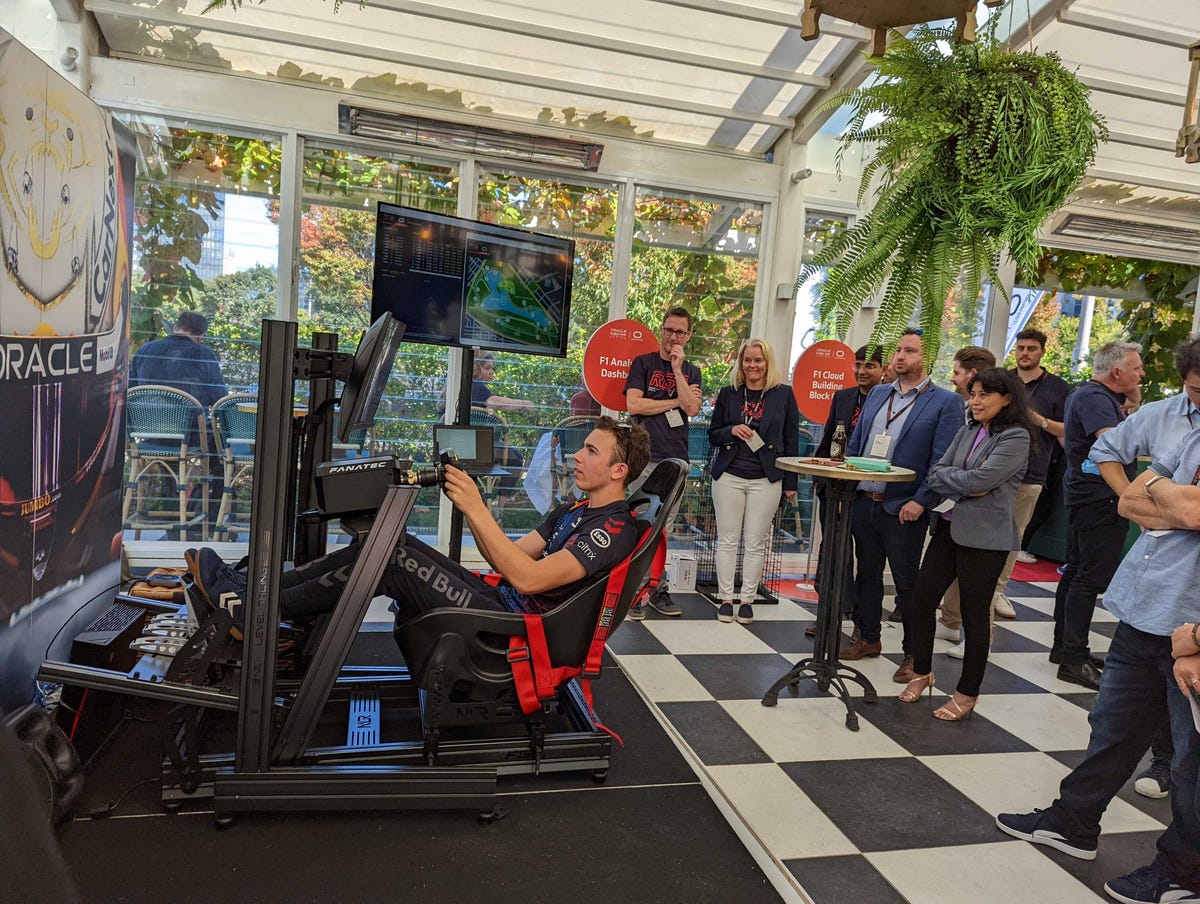
Charles Leclerc of Ferrari, Max Verstappen of Oracle Red Bull Racing, Sergio Perez of Oracle Red Bull Racing, and Lando Norris of McLaren wait on the grid prior to the F1 Grand Prix of Australia at Melbourne Grand Prix Circuit.
Image: Getty Images
In the latest Formula One (F1) season, racing teams have been slapped with a drop in the budget cap, from $145 million to $140 million per team. The dip in approved expenditure has meant individual teams must place more emphasis on cost efficiency and resource management than ever before. By that same token, the technology used by F1 racing teams also carries more importance than in previous seasons.
Each team approaches this cost cap challenge differently, but here are some of the ways F1 racing teams are using technology to shave off dollars this season, from the factory all the way to the race track.
AlphaTauri
The engineers from AlphaTauri have opted to use Epicor’s Kinetic system to analyse production data and create simulations of parts in the hopes of minimising the number of materials used. Through using a data management vendor, AlphaTauri said it can automatically render an entire schematic structure or digital twin of its racing cars.
Essentially, the performance for every part of its car is snapshotted in various sectors of a full race, said Giovanni Cattarina, one of the team’s engineers. By having these renders available, AlphaTauri can pre-empt and eliminate unplanned financial costs, such as the over-ordering of components or wastage of materials,
“The team also has granular visibility into which machine, operator, and tools were used to manufacture each part, helping develop cost-analysis models that inform make-or-buy decisions, as well as quickly correcting any production issues before getting to the track,” Cattarina said.
Carbon fibre is a good example of the importance of these renders, as F1 teams must always have a precise view of how much carbon fibre is in stock — its integrity and lifecycle, and real-time consumption — to enable them to avoid unnecessary over-ordering, especially with the budget cap constraints.
Having those renders in hand also allows AlphaTauri to quickly pinpoint which part of the vehicle is underperforming when analysing a recently finished race.
“It’s actually more important to Giovanni and his team to ensure that the information is available while they’re redesigning and reengineering the vehicle during the race in a live environment which can reduce the amount of time it takes for the team to adapt to change on race day, which is critical for those few milliseconds of improved performance,” Epicor ANZ VP Greg O’Loan said.
Red Bull Racing
Whether it be parts manufacturing or the actual racing itself, investment into improving virtual technology — renders, digital twins, and simulations — appears to be the core focus among teams in order to compete under a budget cap.
Red Bull, runner up in last year’s constructors’ championship and home to reigning world champion Max Verstappen, explained that working with Oracle has allowed it to increase the number of Monte Carlo racing simulations it can run by over 1,000 times. In addition, simulation speed has increased by ten-fold in the past season, meaning Red Bull’s race strategists now have more time to improve the accuracy of their predictions in order to make the right calls.

Red Bull e-sports racer Cooper Webster demonstrates the F1 team’s racing simulator.
Image: Campbell Kwan
But asking a vendor, such as Oracle, to run simulations requires lots of time and energy, which means lots of costs.
For this latest season, one of the ways Red Bull has lowered costs has involved limiting the amount of time it spends using the cloud to run simulations, Red Bull partnerships head Zoe Chilton said.
“If you’re running an on-premise data centre, it’s got to be on all the time — you’re consuming a lot of energy, they consume a lot of resources. Whereas actually what [Red Bull] needs is a huge amount of compute power that we can switch on for the duration of the race weekend and then switch off again the rest of the week because we’re not needing it to be available for us all the time for that very specific task,” Chilton explained.
“So things like this, we’re seeing really impressive efficiencies and the ability to kind of burst to the cloud with these very specific simulation tasks. And wherever there is efficiency, there is going to be a benefit, there’s going to be cost savings, and obviously environmental improvements as well.”
McLaren
McLaren commercial technology head Edward Green stressed the importance of maximising digital twins to succeed under a budget cap.
“They’re critical,” Green said.
From creating driver simulations, to component development, and even through to factory design, McLaren has embedded digital twins to maximise efficiency in these processes.
“The digital twin is used in our simulator. After each race, the drivers will go back and re-drive the race they’ve just finished, which might sound like a strange thing to do but it helps us better calibrate their feedback and understanding of the data coming from the car,” Green explained.
“The digital twin is then also used in part development. We can run simulations, be that aerodynamic or tyre degradation. We run physical simulations against a virtual model of the car.
“By having a digital twin, you can really understand what is going on with the car at all times.”
Beyond using virtual technology to cut costs and find minor improvements, the team is also placing a heightened emphasis on the creation of rapid prototypes, which is often where teams can see larger and more vast improvements.
“Sometimes that rapid prototyping may help inform the way a part is manufactured in full, or it may inform the way it bonds to the other surfaces on the car, and so you can create or 3D print those parts very quickly. The faster you do that, the faster you win the race behind the scenes for parts development,” Green said.
However, as these kinds of rapid prototypes are sometimes designed virtually without the backing of data, there is a risk that they may not pan out and result in unnecessary expenditure.
“Sometimes rapid prototyping is done in parallel as these parts are being developed virtually, and that’s sometimes the gamble you take as a team — before you’ve even seen the data you want to produce the rapid prototype because then you can set to align it further down the line.”
But that’s part of the beauty of F1 racing, Green said, who added that this is something that teams are increasingly doing in a busy racing season.
In the most recent Grand Prix race held in Australia, reliance on this technology has provided great results for some teams, but not for others. Red Bull driver, Sergio Perez, saw a podium finish whilst teammate Verstappen retired with engine trouble. Meanwhile, the McLaren and AlphaTauri drivers all placed lower in the field, from fifth all the way down to fifteenth.
Related Coverage
Unpacking the STEM gap for Australia’s remote Indigenous communities
Resources as basic as Lego are not widely available for Indigenous children in remote Australia.
LeBron James announces pact with Crypto.com for Web3 educational project
The company is still reeling from a $30 million hack that occurred last week.
AWS signs cloud innovation deal with owner of Toronto Maple Leafs, Raptors, FC and Argonauts
Maple Leaf Sports & Entertainment will use a range of AWS-enabled artificial intelligence, machine learning, and deep learning cloud services.
How SailGP is using IoT and data to improve performance
The boats each use over 400 sensors to provide more than 12,000 data points.


